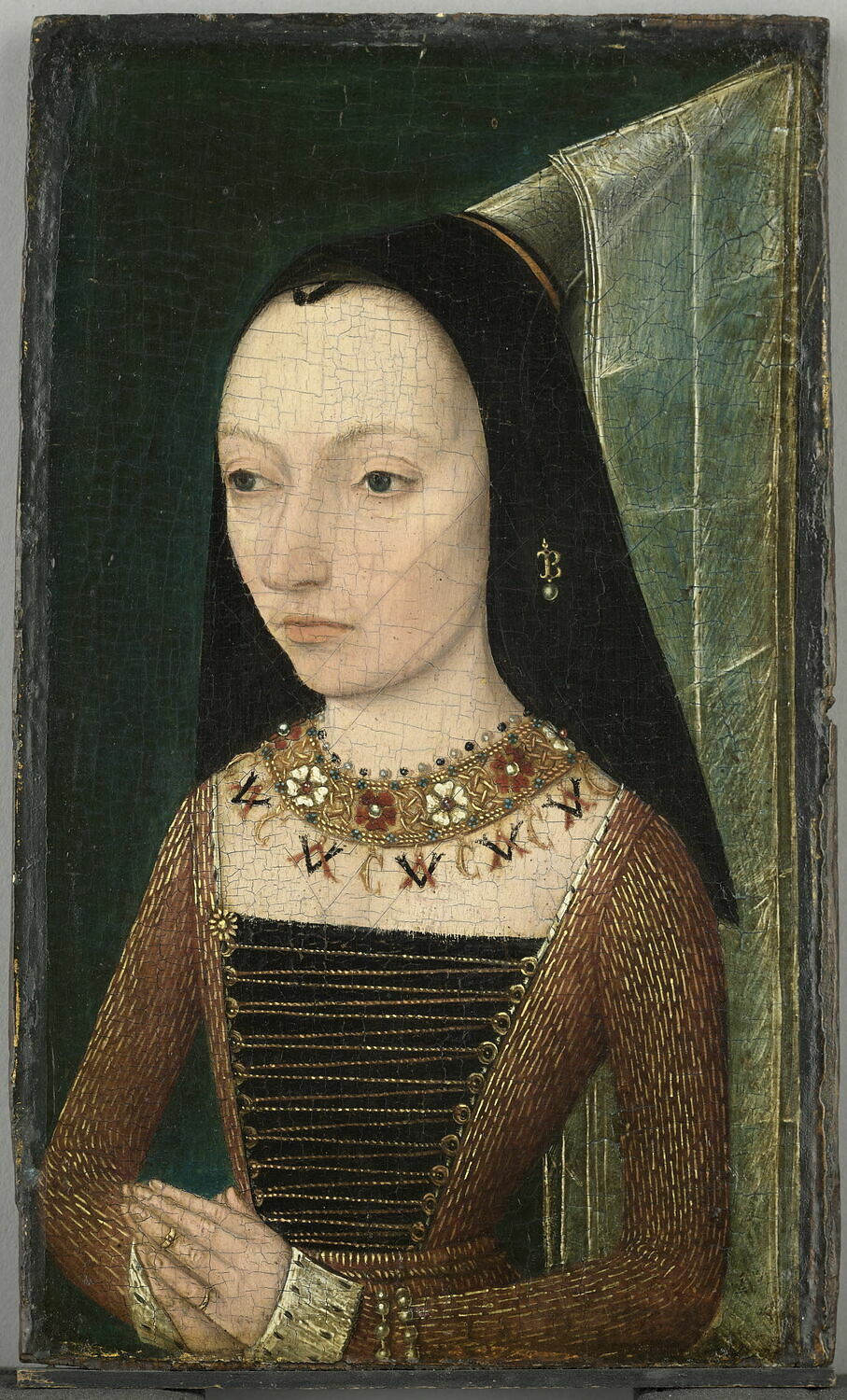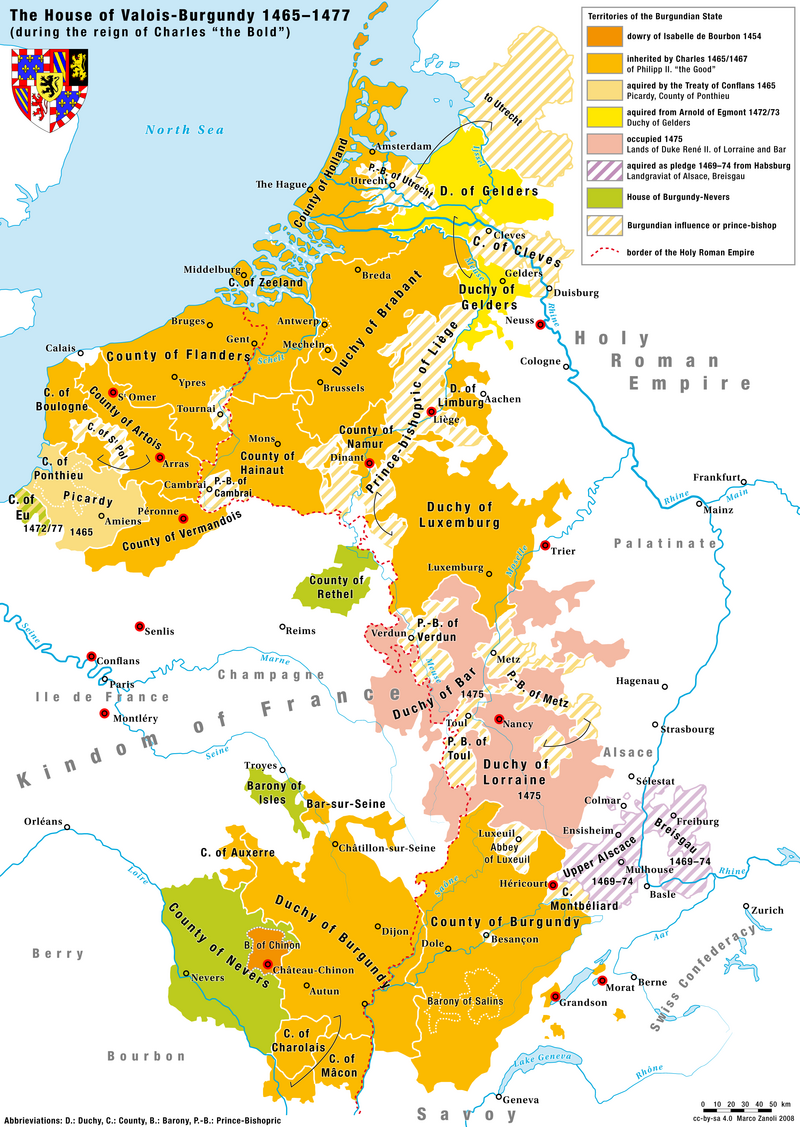by Susan Flantzer
© Unofficial Royalty 2023

Mary, Duchess of Burgundy; Credit – Wikipedia
Mary, Duchess of Burgundy, in her own right, was the only child of Charles I the Bold, Duke of Burgundy, and the second of his three wives Isabella of Bourbon. She was born on February 13, 1457, at the Palace of Coudenberg in Brussels, Duchy of Brabant in the Burgundian State, now in Belgium. Mary’s paternal grandparents were Philip III the Good, Duke of Burgundy, and the third of his three wives, Isabella of Portugal. Her maternal grandparents were Charles I, Duke of Bourbon and Agnes of Burgundy, also Mary’s paternal great-aunt. At the time of Mary’s birth, her paternal grandfather Philip III the Good was Duke of Burgundy.
Mary was baptized Marie-Blanche (in French) on February 17, 1457, in the chapel at the Palace of Coudenberg by Jean of Burgundy, Bishop of Cambrai, who was the illegitimate son of Mary’s great-grandfather Jean I the Fearless, Duke of Burgundy. Mary’s grandfather Philip III the Good, Duke of Burgundy, chose not to attend the baptism as it was only for a girl.
Mary’s godparents were:
- Isabella of Portugal, Duchess of Burgundy, her paternal grandmother
- Louis, Dauphin of France, the future Louis XI, King of France
Mary’s aunt Anne of Burgundy, the illegitimate daughter of Mary’s grandfather Philip III the Good, Duke of Burgundy, was put in charge of her niece and appointed Jeanne de Clito as Mary’s governess. Jeanne was Mary’s constant companion for the rest of her life. Mary received an excellent education befitting a future reigning Duchess of Burgundy. She enjoyed music, art, and chess, but physical exercise was her greatest love. Mary especially enjoyed hunting, riding, falconry, and skating on the frozen ponds of the Palace of Coudenberg.

Mary’s father Charles I the Bold, Duke of Burgundy; Credit – Wikipedia
When Mary was eight years old, in 1465, her mother Isabella of Bourbon died from tuberculosis. In 1467, Mary’s grandfather, Philip III the Good, Duke of Burgundy, died, and her father succeeded as Charles I, Duke of Burgundy. Charles had three marriages, but ten-year-old Mary was his only child and became his heir presumptive.

Margaret of York, Mary’s stepmother; Credit – Wikipedia
In 1468, Mary’s widowed father married his third wife, the English Margaret of York, the daughter of Richard Plantagenet, 3rd Duke of York, the leader of the House of York during the Wars of the Roses until he died in battle in 1460. Margaret was also the sister of King Edward IV of England and King Richard III of England. Margaret and Charles were half-second cousins. They were both great-grandchildren of John of Gaunt, Duke of Lancaster, the third surviving son of King Edward III, but from different wives of John. The first meeting of Margaret of York with Charles’s mother Isabella of Portugal, and 11-year-old Mary was a resounding success, and the three of them would remain close for the rest of their lives.

The Burgundian State during the reign of Charles the Bold; Credit – By Marco Zanoli, CC BY-SA 4.0, https://commons.wikimedia.org/w/index.php?curid=3977827
The vast and rich Burgundian State comprised parts of the present-day Netherlands, Belgium, Luxembourg, France, and Germany. Because of this, Mary had many suitors for her hand in marriage, including the future King Charles VIII of France, Nicholas I, Duke of Lorraine, and George Plantagenet, Duke of Clarence, supported by his sister and Mary’s stepmother, Margaret of York. As early as 1463, when Mary was just six years old, Pope Pius II first suggested a marriage between Mary and four-year-old Archduke Maximilian of Austria, son of Friedrich III, Holy Roman Emperor and Archduke of Austria and Infanta Eleanor of Portugal. In the fall of 1473, the two fathers, Friedrich III and Charles the Bold, met to discuss a possible marriage. However, the negotiations failed and ended after two months.

Mary’s husband Maximilian; Credit – Wikipedia
Mary’s father’s main objective was to become a king by acquiring territories bordering and in between the territories of the Burgundian State. This caused the Burgundian Wars (1474 – 1477). On January 5, 1477, Charles I (the Bold), Duke of Burgundy was killed at the Battle of Nancy, and twenty-year-old Mary of Burgundy became the Duchess of Burgundy in her own right. Because Mary feared that King Louis XI of France would try to force her to marry his eldest son, she resumed marriage negotiations with Holy Roman Emperor Friedrich III to marry his son Maximilian. King Louis XI of France tried to prevent the marriage by declaring that he was Mary’s overlord and refusing to consent to the marriage. However, Friedrich III agreed to the marriage of his son Maximilian and Mary. A proxy marriage was held on April 21, 1477, at Mary’s home, the Priesendorf in Bruges, County of Flanders, one of Mary’s lands, now in Belgium. On August 18, 1477, Maximilian arrived in Ghent, County of Flanders, now in Belgium, and on the next day, Maximilian and Mary were married in person.
Mary and Maximilian had three children:
- Philip IV, Duke of Burgundy (1478 – 1506), also called Philip of Habsburg and Philip the Handsome, married Juana I, Queen of Castile and León, Queen of Aragon, had six children, all were kings or queen consorts
- Margaret of Austria, Governor of the Habsburg Netherlands (1480 – 1530), married (1) Juan of Aragon, Prince of Asturias, the only son and heir of King Ferdinand II of Aragon and Queen Isabella I of Castile, no children, died from tuberculosis (2) Philibert II, Duke of Savoy, no children
- Franz of Austria (born and died 1481)

Mary and Maximilian’s grandson Charles V, Holy Roman Emperor; Credit – Wikipedia
It was through the marriage of Maximilian and Mary’s son Philip to Juana I, Queen of Castile and León, Queen of Aragon that the Habsburg lands would be joined with the Spanish lands. Philip and Juana’s son Carlos, best known as Charles V, Holy Roman Emperor, was one of the most powerful ever monarchs and had many titles due to his vast inheritance of the Burgundian, Spanish, and Austrian realms. Carlos I was not only the first King of a united Spain and Charles V, Holy Roman Emperor, but also Charles I, Archduke of Austria, and Charles II, Lord of the Netherlands, among many other titles.
Mary’s reign as Duchess of Burgundy and her marriage to Maximilian lasted only five years. In March 1482, despite being pregnant, Mary participated in a hunt in the woods near Wijnendale Castle in Flanders. She was an experienced rider and held her falcon in one hand and the reins in the other hand. However, Mary’s horse stumbled over a tree stump while jumping over a newly dug canal. The saddle belt under the horse’s belly broke, causing Mary to fall out of the saddle and into the canal with the horse on top of her. Mary died from internal injuries, aged twenty-five, several weeks later, on March 27, 1482, at Wijnendale Castle, Flanders, Burgundian Netherlands, now Wijnendale, West Flanders in Belgium. She was buried in a beautiful tomb next to her father in the Church of Our Lady in Bruges in the County of Flanders, now in Belgium. Maximilian and Mary’s son Philip, who was not quite four years old, succeeded his mother as ruler of the Burgundian State under the guardianship of his father Maximilian.

Tomb of Mary, Duchess of Burgundy; Photo Credit – © Susan Flantzer
After Mary’s death, Maximilian’s father, Friedrich III, Holy Roman Emperor and Archduke of Austria, died in 1493, and Maximilian succeeded to the Habsburg hereditary lands, becoming the reigning Archduke of Austria. He also became the de facto ruler of the Holy Roman Empire via his election as King of the Romans, heir to the Holy Roman Emperor, in 1486. In 1508, Maximilian proclaimed himself the elected Holy Roman Emperor with the approval of Pope Julius II, ending the long tradition of requiring a papal coronation for the adoption of the Holy Roman Emperor title.
After a very short marriage in name only to Anne, Duchess of Brittany in her own right, which the French forced Anne to annul, Maximilian married again, in 1494, to Bianca Maria Sforza. The marriage was not a happy one. Maximilian complained that Bianca Maria may have been more beautiful than his first wife, Mary of Burgundy, but she was not as intelligent. Maximilian survived his first wife Mary by thirty-seven years, dying on January 12, 1519, aged 59 at the Castle of Wels in Wels, Upper Austria, now in Austria. He was buried at St. George’s Cathedral in Wiener Neustadt Castle in Wiener Neustadt in Lower Austria, now in Austria. However, as per his will, Maximilian’s heart was placed in the tomb of his first wife, Mary, Duchess of Burgundy, in the Church of Our Lady in Bruges, County of Flanders, now in Belgium.
This article is the intellectual property of Unofficial Royalty and is NOT TO BE COPIED, EDITED, OR POSTED IN ANY FORM ON ANOTHER WEBSITE under any circumstances. It is permissible to use a link that directs to Unofficial Royalty.
Works Cited
- Abernethy, Susan. (2013) Mary of Burgundy, The Freelance History Writer. Available at: https://thefreelancehistorywriter.com/2013/03/23/mary-of-burgundy/ (Accessed: 03 May 2023).
- Flantzer, Susan. (2022) Margaret of York, Duchess of Burgundy, Unofficial Royalty. Available at: https://www.unofficialroyalty.com/margaret-of-york-duchess-of-burgundy/ (Accessed: 03 May 2023).
- Flantzer, Susan. (2023) Maximilian I, Holy Roman Emperor, Archduke of Austria, Unofficial Royalty. Available at: https://www.unofficialroyalty.com/maximilian-i-holy-roman-emperor-duke-of-styria-carinthia-and-carniola-archduke-of-austria/ (Accessed: 03 May 2023).
- Marie de Bourgogne (2023) Wikipedia (French). Available at: https://fr.wikipedia.org/wiki/Marie_de_Bourgogne (Accessed: 03 May 2023).
- Maria von Burgund (2023) Wikipedia. Available at: https://de.wikipedia.org/wiki/Maria_von_Burgund (Accessed: 03 May 2023).
- Mary of Burgundy (2023) Wikipedia. Available at: https://en.wikipedia.org/wiki/Mary_of_Burgundy (Accessed: 03 May 2023).
